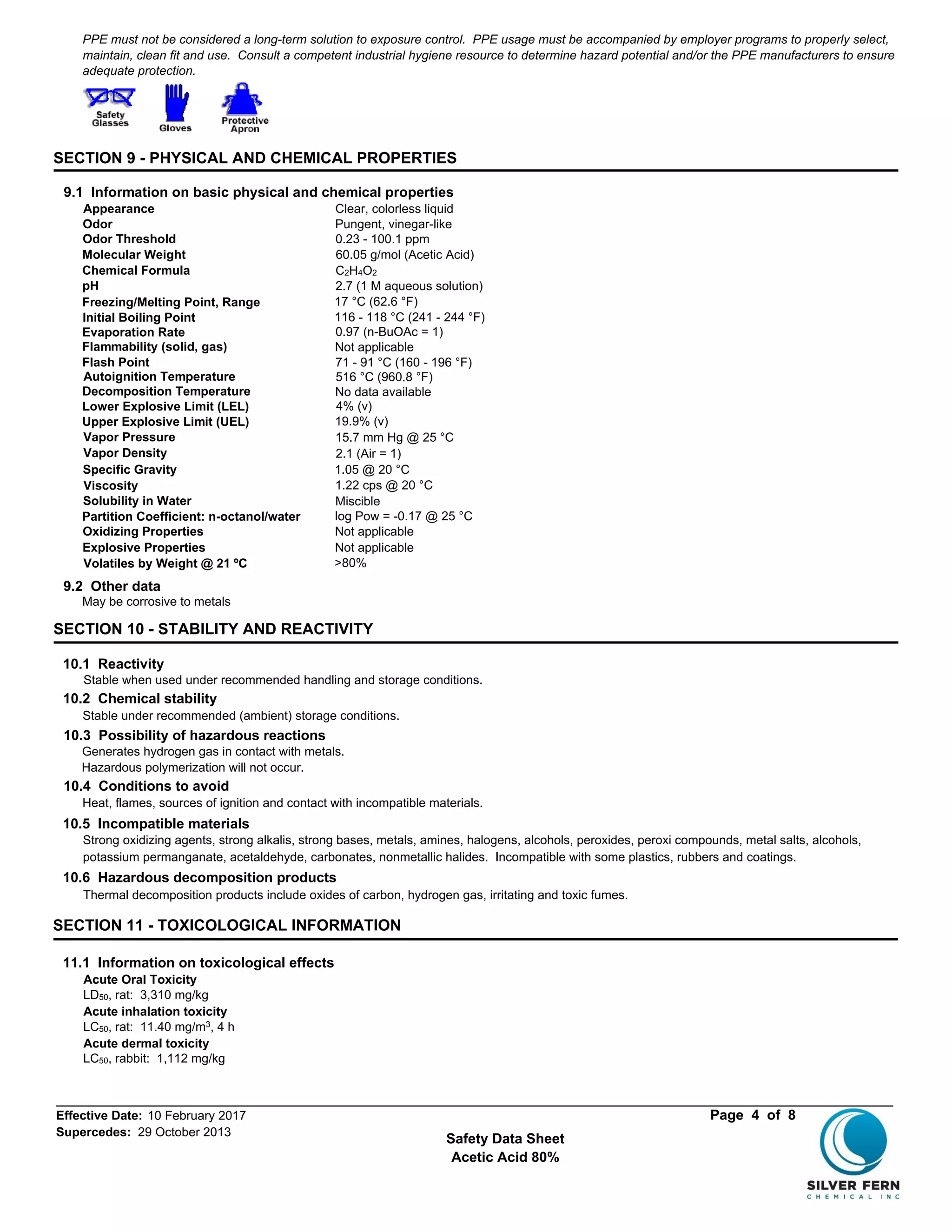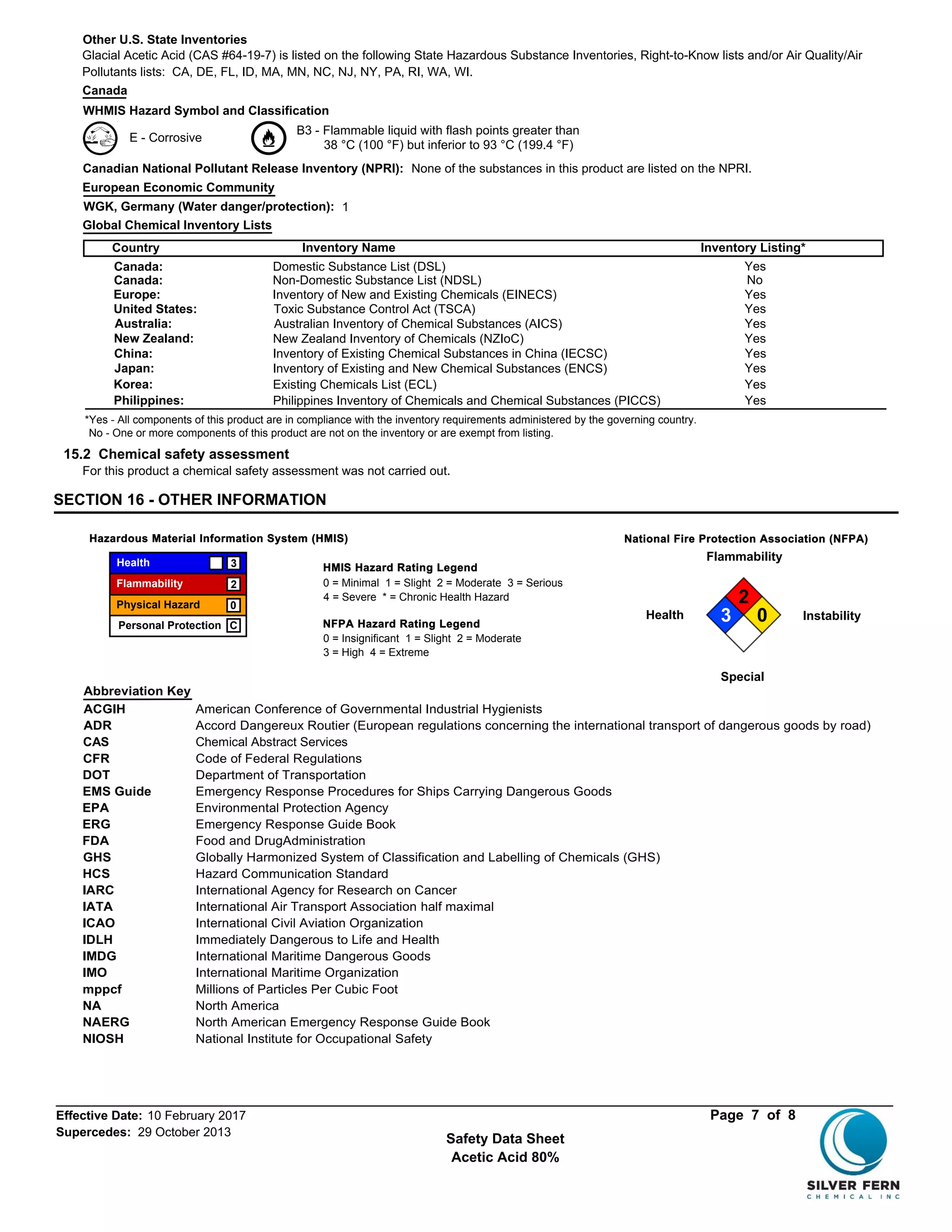The document is a safety data sheet for Acetic Acid 80%, detailing its hazards, safety measures, and appropriate handling practices. It highlights the substance's classification as flammable and corrosive, potential health effects from exposure, and first aid measures. Additionally, it provides guidelines for storage, disposal, and emergency contact information.
![Product Name: Acetic Acid 80%
1-866-282-3384
General use:
SECTION 2 - HAZARDS IDENTIFICATION
Silver Fern Chemical, Inc.
Manufacturer/Distributor
2226 Queen Anne Avenue North
Seattle, WA 98109 USA
Industrial applications
Synonym(s): Ethanoic acid, aqueous solution
1.2 Relevant identified uses of the substance or mixture and uses advised against
1.1 Product identifier
1.3 Details of the supplier and of the safety data sheet
1.4 Emergency telephone number: INFO-TRAC +1-800-535-5053; Outside USA & Canada +1-352-323-3500
REACH Registration Number: No data available at this time
Uses advised against: None known
SECTION 1 - PRODUCT AND COMPANY IDENTIFICATION
_________________________________________________________________________________________________________________________
Effective Date: Page 1 of 8
Safety Data Sheet
Acetic Acid 80%
Suite C
Supercedes: 29 October 2013
SILVER FERN CHEMICAL, INC.
Safety Data Sheet
10 February 2017
Website - www.silverfernchemical.com; email address - info@silverfernchemical.com
2.1 Classification of substance or mixture
Product definition: Mixture
Flammable liquid - Category 3 [H226]
Skin corrosion - Category 1A [H314]
Classification in accordance with 29 CFR 1910 (OSHA HCS) and Regulation EC No. 1272/2008
Acetic Acid 80%
2.2 Label Elements
Hazard Symbol(s):
Signal Word:
Hazard Statement(s):
[Prevention]
Precautionary Statements:
Danger
H226 - Flammable liquid and vapor
[Response]
P301 + P330 + P331 + P310 - IF SWALLOWED: Rinse mouth. Do NOT induce vomiting. Immediately call a
POISON CENTER or doctor.
P303 + P361 + P350 - IF ON SKIN: Remove immediately all contaminated clothing. Rinse skin with water or
P264 - Wash hands and other skin areas exposed to material thoroughly after handling.
P305 + P351 + P338 + P310 - IF IN EYES: Rinse cautiously with water for several minutes. Remove contact
lenses, if present and easy to do. Continue rinsing. Immediately call a POISON Center or doctor.
P304 + P340 + P310 - IF INHALED: Remove victim to fresh air and keep at rest in a position comfortable for
breathing. Immediately call a POISON CENTER or doctor.
shower.
P280 - Wear protective gloves, protective clothing, eye protection and face protection.
P321 - Specific treatment: Contact a POISON CENTER or doctor. Refer to Section 4 of this SDS.
P260 - Do not breathe vapor, fumes or mist.
P363 - Wash contaminated clothing before reuse.
P210 - Keep away from heat, open flames and hot surfaces. No smoking.
P233 - Keep container tightly closed.
P240 - Ground and bond container and receiving equipment.
P241 + P242 - Use explosion-proof electrical, ventilating, lighting, and mixing equipment; use only non-sparking tools.
P243 - Take precautionary measures against static discharge.
P370 + P378 - In case of fire: Use water spray or fog, foam, dry chemical or carbon dioxide for extinction.
H314 - Causes severe skin burns and eye damage
GHS02 GHS05](https://image.slidesharecdn.com/materialsafetydatasheetaceticacid-aceticacid80-170929072301/75/Material-Safety-Data-Sheet-ACETIC-ACID-Acetic-Acid-80-1-2048.jpg)
![SECTION 4 - FIRST AID MEASURES
_________________________________________________________________________________________________________________________
Page 2 of 8
3.2 Mixtures
Not applicable
SECTION 5 - FIRE FIGHTING MEASURES
Effective Date:
Safety Data Sheet
Supercedes: 29 October 2013
10 February 2017
SECTION 3 - COMPOSITION/INFORMATION ON INGREDIENTS
3.1 Substances
% by Weight CAS Number EC NumberIngredient GHS Classification
Glacial Acetic Acid 64-19-7 200-580-7 607-002-00-6 H226, H314
Annex Number
There are no ingredients present in this product which, within the current knowledge of the supplier and in the concentrations applicable, are
classified as hazardous to health or the environment and hence require reporting in this section.
50 - 80
Ingestion: Rinse mouth with water if the victim is conscious. Remove dentures, if any. Give 2 glasses of water or milk to drink if the victim is
conscious, alert and able to swallow. DO NOT induce vomiting unless directed to do so by medical personnel. Never give anything by mouth to an
4.2 Most important symptoms and effects, both acute and delayed
Eyes:
Ingestion:
Causes severe skin irritation and burns. May be harmful if absorbed through the skin. Contact with skin may cause blackening andSkin:
Potential health symptoms and effects
Chronic exposure may cause erosion of dental enamel, bronchitis, eye irritation, darkening of the skin and chronic inflammation of the
respiratory tract. May cause occupational asthma. Effects may be delayed. Skin sensitization to acetic acid is rare, but has occurred. Persons
Chronic:
Causes burns serious eye damage. Symptoms may include redness, swelling, pain, tearing, burns, blurred vision, corneal clouding,
Harmful if swallowed. Causes burns to the lips, mouth, throat and gastrointestinal tract. May cause severe and permanent damage to
permanent eye damage and possible blindness. Mist or vapor can cause severe eye irritation and eye damage.
Harmful if inhaled. Causes chemical burns to the respiratory tract with mucousal irritation, cough and shortness of breath. ExposureInhalation:
may lead to bronchitis, pharyngitis, edemas in the respiratory tract and dental erosion. Effects may be delayed. May be absorbed though the lungs.
unconscious or convulsing person. Do not leave the victim unattended. To prevent aspiration of swallowed product, lay victim on one side with
Eyes:
if present and easy to do, after the first 2 minutes and continue rinsing. Seek immediate medical attention, preferably from an ophthalmologist.
Immediately flush eyes with large amounts of water for 15 minutes, occasionally lifting the upper and lower lids. Remove contact lenses,
Skin: Flush skin with large amounts of water while removing contaminated clothing, and continue rinsing for at least 15 minutes. Wash
difficult or irregular, administer oxygen; if respiratory arrest occurs, start artificial respiration by trained personnel. Loosen tight fitting clothing
Inhalation:
4.1 Description of first aid measures
If product vapor or mist causes respiratory irritation or distress, move the exposed person to fresh air immediately. If breathing is
contaminated clothing thoroughly before reuse. Discard contaminated shoes. Seek immediate medical attention.
such as a collar, tie, belt or waistband. Seek immediate medical attention.
4.3 Indication of any immediate medical attention and special treatment needed
Advice to Doctor and Hospital Personnel
Treat symptomatically and supportively.
the head lower than the waist. Obtain medical attention immediately.
absorbed from the gastrointestinal tract. Pulmonary failure is possible after aspiration of vomit.
the digestive tract. Causes severe pain, nausea, vomiting, diarrhea and shock. May cause damage to the kidneys and kidney failure. Rapidly
Suitable methods of extinction: Use extinguishing media such as water fog or spray, dry chemical, carbon dioxide or foam.
5.1 Extinguishable media
Unsuitable methods of extinction: None known
5.2 Special hazards arising from the substance or mixture
5.3 Advice for firefighters
Full protective equipment including self-contained breathing apparatus should be used. Water may be used to cool closed containers to prevent
Vapor may form an explosive mixture with air at elevated temperatures, especially in confined spaces.Explosion hazards:
[Disposal] P501 - Dispose of contents and containers in accordance with national and local regulations.
[Storage] P405 + P403 + P233 + P235 - Store locked up in a well-ventilated place. Keep container tightly closed. Keep cool.
2.3 Hazards not otherwise classified (HNOC) or not covered by GHS
None identified
with pre-existing skin disorders or impaired respiratory or pulmonary function may be at increased risk to the effects of this substance.
hyperkeratosis of the skin and hands.
Flammable liquid and vapor. Approach fire from upwind to avoid hazardous vapors and toxic decomposition products. Vapors are heavier than air
and can travel along the ground to a source of ignition and flash back. Vapors can spread along the ground and collect in low or confined areas.
Containers may explode if exposed to fire. During a fire, irritating and highly toxic gases may be generated by thermal decomposition or combustion.
Symptoms of overexposure to these gases may not be apparent. Seek medical advice.
Acetic Acid 80%](https://image.slidesharecdn.com/materialsafetydatasheetaceticacid-aceticacid80-170929072301/75/Material-Safety-Data-Sheet-ACETIC-ACID-Acetic-Acid-80-2-2048.jpg)





